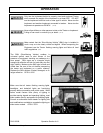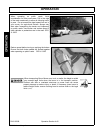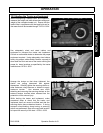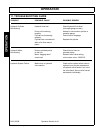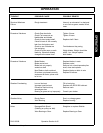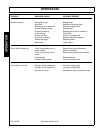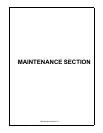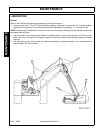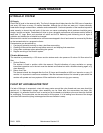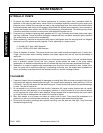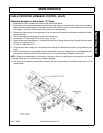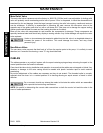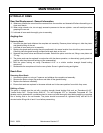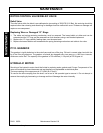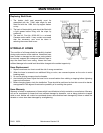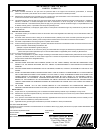
MAINTENANCE
PA91 03/09 Maintenance Section 5-3
© 2009 Alamo Group Inc.
MAINTENANCE
HYDRAULIC SYSTEM
Oil Supply
Check the oil level in the reservoir daily. The first oil change should take place the first 250 hours of operation
and every 500 hours or every 12 months thereafter. Although the oil does not wear out, it does eventually
break down through contamination, oxidation and condensation. Continual operation of the machine beyond its
rated capacity to almost the stall point of the rotor can cause overheating which produces insoluble gums,
sludge, varnish and acids. Overheated oil thins to give a sluggish performance and causes earlier failure of
seals and “O” rings. Burnt and scorched oil odors and the oil darkening and thickening are all signs of
oxidation and indicate the oil should be changed.
Moisture which results from condensation can become entrapped in the oil and cannot be removed by filtration
so that contamination is a progressive factor.
Contamination can be reduced by:
1. Carrying all hydraulic servicing in clean, dust-free surrounding.
2. Cleaning off around the reservoir cap before removal, and keeping that area clean.
3. Using clean containers when replenishing the system.
4. Regular servicing of the filtration system.
Filtration Maintenance
The machine is protected by a 125 micron suction strainer and a low pressure 10 micron full flow return line
filter.
1. Suction Strainer
The strainer is fixed in position within the reservoir. Should indications of pump cavitation or spongy
intermittent operation occur the tank must be drained and flushed out with a suitable cleaning agent, e.g.
clean diesel oil.
2. Return Line Filter
The element should be changed after the first 50 hours and thereafter at 400 hour intervals or every 12
months. It is important to note hours worked as if the filter becomes blocked. An internal by-pass within the
canister will operate and no symptoms of filter malfunction will occur to jog your memory.
FLOAT KIT ACCUMULATOR TEST
If a leak of Nitrogen is suspected, a test with soapy water around the valve thread and core area should be
carried out. A replacement charge valve assembly can be fitted after the accumulator has been fully
discharged. It is essential that this work is carried out by the dealer or distributor who must have the facilities
for recharging. The accumulator can be removed for this purpose. If oil is leaking from the area of the charge
valve then the internal butyl bag is damaged and the accumulator is scrap.



